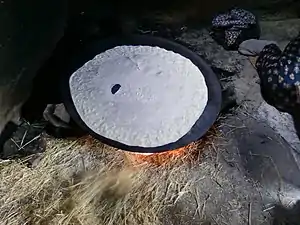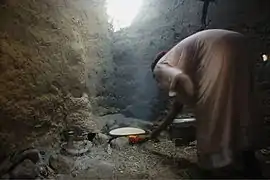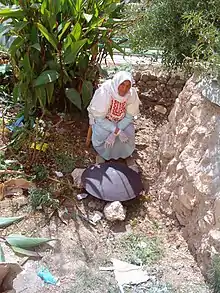 Unleavened yufka bread made on griddle | |
| Alternative names | Tava bread |
|---|---|
| Type | Flatbread |
| Place of origin | Middle East, South Asia |
| Main ingredients | flour, water, salt |
Saj bread (Arabic: خبز صاج, romanized: khubz ṣāj, Turkish: sac ekmeği) or tava bread (Hindi: तवा रोटी, romanized: tavā roṭī) is unleavened flatbread in Middle Eastern and South Asian cuisines baked on a metal griddle, called saj in Arabic and tava in the Indian subcontinent (concave in India and convex in Pakistan).
Types
Middle East
Bread
Yufka bread (Turkish: yufka ekmeği) is the Turkish name of a very thin, large (60 cm [24 in]) unleavened flatbread in Turkish cuisine, also known under different names in Arab cuisine, baked on a convex metal griddle, called saj in Arabic and saç in Turkish.[1][2][3]
Arab saj bread is somewhat similar to markook shrek, but is thinner and larger.[4]
In Palestine, the saj bread is simply called shrāke, differing from the markook, which is baked in a clay oven (tannur).[4]
In Cyprus, it is known as pitta saji. It is eaten as a snack. The dough is lightly sweetened with honey and cinnamon.[5]
Stuffed bread
Gözleme is a savory, soft Turkish stuffed flatbread, cooked on the convex saç.[6][7]
Indian sub-continent
Tava roti bread
Gallery
_-_Location_in_Kolur%252C_Javanrud_County%252C_Kermanshah_Province_in_Iran.JPG.webp) Kurdish bread (Iran)
Kurdish bread (Iran) Qurasah (Sudan)
Qurasah (Sudan) Roti (India)
Roti (India) Shrāke (Palestine)
Shrāke (Palestine) Yufka bread (Turkey)
Yufka bread (Turkey)
See also
- Markook, another bread called "saj bread"
- Chapati
- List of flatbreads
References
- ↑ "Kitchen Secrets / Some Saj' Advice". Haaretz.
- ↑ Türk Dil Kurumu, Büyük Türkçe Sözlük search form Archived 2015-05-15 at the Wayback Machine
- ↑ Pitta tis Satzis
- 1 2 Dalman, Gustaf (1964) [1935]. Arbeit und Sitte in Palästina [Work and Customs in Palestine] (in German). Vol. 4 (Bread, oil and wine) (reprint ed.). Hildesheim. OCLC 312676221.
{{cite book}}: CS1 maint: location missing publisher (link), Photographic illustration no. 30 "Dreizehn Brotarten", 'Thirteen bread types'. - ↑ https://www.productsfromcyprus.com/en-us/products/pitta-saztis
- ↑ Koz, M. Sabri (2002). Yemek kitabı: tarih, halkbilimi, edebiyat. Kitabevi. ISBN 978-975-7321-74-3.
- ↑ Halıcı, Feyzi (1993). Dördüncü Milletlerarası Yemek Kongresi: Türkiye, 3-6 Eylül 1992. Konya Kültür ve Turizm Vakfı.
External links
- Tutorial: How to make Saj Bread on YouTube (Arabic)
